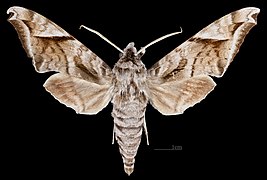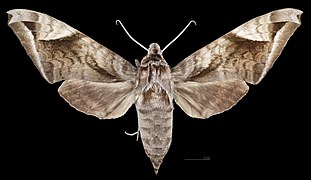Acosmeryx naga
| Acosmeryx naga | ||||||||||||
|---|---|---|---|---|---|---|---|---|---|---|---|---|

Acosmeryx naga naga |
||||||||||||
| Systematics | ||||||||||||
|
||||||||||||
| Scientific name | ||||||||||||
| Acosmeryx naga | ||||||||||||
| ( Moore , 1857) |
Acosmeryx naga is a butterfly ( moth ) from the family of moth (Sphingidae). There are two known subspecies. In addition to the nominate subspecies, Acosmeryx naga hissarica is described, whose type locality is The Vakhsh Valley in the Hissar Mountains in Tajikistan and to which the species also owes its subspecies name.
features
butterfly
The moths have a wingspan of 82 to 103 millimeters, with those of the subspecies Acosmeryx naga naga being slightly larger than Acosmeryx naga hissarica . The species can easily be distinguished from the rest of the genus Acosmeryx by the pattern of its front wings. These carry a dark, brownish discal band on the upper side, which extends from the costa along the wing vein M 2 to near the middle of the wing's outer edge. The band is sharply demarcated towards the wing leading edge. The triangular part of the fore wing, which is formed by it towards the front towards the leading edge of the wing, is gray. A clearly recognizable gray submarginal bandage runs more or less straight from the Rs 4 vein to the tip of 1A + 2A. The two subspecies can be distinguished by the fact that the conspicuous discal band is straight in the nominate subspecies, whereas in Acosmeryx naga hissarica it is clearly curved. The latter subspecies also has significantly more gray components in its basic color and appears much lighter in color than the nominate subspecies.
In the male genitalia, the gnathos has parallel margins. The process of the harpe is quite pointed distally and resembles a hand with the thumb next to the index finger and the other fingers curved backwards and upwards. The left lobe of the Aedeagus is shorter than that of any other species of the genus Acosmeryx . In the female genitals, the ostial plate is similar to that of the females of Acosmeryx anceus .
Caterpillar
The caterpillars are 70 to 90 millimeters (subspecies hissarica ) or 80 to 100 millimeters (nominate subspecies) long and come in a green or brown color variant. In the first stage, her head and body are green, the long and straight anal horn is black. In the second stage, the first segment of the thorax is as narrow as the head, with the body tapering towards the front from the first abdomen segment . Even at this stage, the anal horn is long and straight, but has a reddish basal color and a white tip. The head and the last abdominal segments are yellow, the rest of the body is green with white dots. The spiracles on the first abdominal segment are in a black spot. A yellow dorsolateral longitudinal line runs from the head to the anal horn. During the third and fourth stages the coloration of the animals does not change, only a brim forms on the side of the third thoracic and first abdominal segment and is bordered by a yellow ventro-lateral stripe. In the final stage, the caterpillars of the green color variant have a grass-green head with a pale, yellowish dorsolateral stripe and an equally colored wider stripe that separates the face from the cheeks. The first two thorax segments are also grass green and have short, darker stripes. The rest of the body is bluish-green and yellow above the dorsolateral stripe and pale grayish blue mottled below. The dorsolateral stripe itself is narrow and white on the first two thoracic segments, wider and pale yellow on the third thoracic and first abdominal segment, and behind it white to the anal horn. It has a narrow orange border on the top of the third to the seventh abdominal segment. The narrow white ventrolateral line becomes wider and yellow on the first two thorax segments along the dark brim and runs upwards on the first abdominal segment, thus forming an oblique stripe there. Pale, yellow oblique stripes appear on the first to the seventh abdominal segment. The anal horn is lavender gray and dotted purple. Above the base of the legs there are dark purple spots that become larger caudally and extend over the brim on the third thoracic and first abdomen segments. The upper part of the abdomen is bluish, the lower part is pale yellow. The claws are brown. The pusher is bluish, the anal valves have a wide pale yellow border. The stigmas are dark orange in color. In the brown color variant of the caterpillars, the green color is replaced by pinkish-brown. The entire body is smooth and moderately shiny.
Doll
The doll is 44 to 55 millimeters long. It is very similar to those of the genus Clarina , but has a dark brown back and pale brown colored sides and ventral sides. The surface is shiny. The abdomen is provided with short, dark stripes and pits. There is a pale brown spot in front of the eye. Between the end and the proboscis is a höckeriges, pentagonal sclerite . The rear edge of the seventh abdominal segment is deeply undercut. The rear flats on segments 8 to 11 are dark brown. The stigmas are outlined in black and dark brown. The stigma of the second segment is obscured by a narrow, sloping lobe that rises from the front edge of the third segment. The front edge of the lobe is sharply protruding. The other spiracles are short-oval and have no elevation, but their central opening is raised. The almost black cremaster is small at about two millimeters in length, has a bulbous basal half and is designed on the second half as a cylindrical shaft that ends in two small hooks. The dorsal part of the basal half has a honeycomb structure.
egg
The eggs are deep and bright green in color and turn whitish shortly before the caterpillars hatch. They are almost spherical and have a smooth surface.
Occurrence and habitat
The nominate subspecies is distributed from the foothills of the Himalayas in Pakistan via India and Nepal, the south and east of China to Taiwan, Korea and Japan. It also occurs in Burma, Thailand, Laos, Vietnam and Malaysia on the Malay Peninsula . In 2002 and 2003 several migrant butterflies were sighted in Far Eastern Russia, although it is conceivable that the species was able to establish a native population in the southeast of Ussuriysk . The subspecies hissarica occurs only in southern Tajikistan and Afghanistan. Evidence of this subspecies from the south of China and the north of Vietnam is probably due to incorrect identification of the species Acosmeryx purus , which was first described in 2014 .
The moths colonize mountain valleys and gorges with and without agricultural use. Along the southern slopes of the Hissar Mountains in Tajikistan, it has also been detected in humid habitats in ravines between 1,100 and 1,700 meters above sea level with vegetation of real walnut ( Juglans regia ) and Acer turkestanicum overgrown with grapevines ( Vitis vinifera ). In Afghanistan the species occurs between 1500 and 2500 meters above sea level.
Way of life
Flight and caterpillar times
The subspecies hissarica flies in two generations from late April to June and in late July. The nominate subspecies flies in China from late April ( Beijing ), May ( Zhejiang , Guangdong ), June ( Yunnan , Hainan ) to July ( Tibet ), in Taiwan it flies from March to May ( Kaohsiung ) or June ( Hualien ). It is detected in North Korea from mid to late May ( P'yŏngan-pukto ), in Japan at the end of March ( Kyushu ), at the end of April and May ( Honshu ), in May ( Ryukyu Islands ) and at the end of May ( Hokkaidō ). In Russia ( Primorsky Krai ), the species flies from early to mid-July. In northern China there is only one generation per year that flies from April to June. Park et al. (1999) state the flight time for Korea from May to mid-August.
June to September is given as the time of occurrence for the caterpillars of the subspecies hissarica .
Food of the caterpillars
The caterpillars feed mainly on grapevines ( Vitis ) and Ampelopsis from the grapevine family (Vitaceae). They have been found on grapevines ( Vitis vinifera ) in Kabul in Afghanistan , on Vitis amurensis , Ampelopsis brevipedunculata and Ampelopsis heterophylla in Russia and on Stathmopoda auriferella , Ampelopsis brevipedunculata and grapevines in Korea . The caterpillars are also rarely found on ray pens ( Actinidia ) and Saurauia from the ray pen family (Actinidiaceae).
development
The caterpillars rest on the underside of leaves or branches of their food plants. If they are disturbed, they throw their head and the front body segments backwards in a sharp curve, typical of a swarm. Your head then lies in the same plane as the back of the first abdominal segment. The thoracic legs are placed close to the body and the brim is widened to the side. As with Clarina kotschyi , whose caterpillars resemble the caterpillars of Acosmeryx naga , the animals pull their head and the first two thorax segments into the third. In contrast to the similar species, however, the third thoracic and first abdominal segments are puffy and the brim is thereby further enlarged. Pupation takes place in a thin cocoon on the ground. The pupa is very sensitive to drought, but can withstand high levels of moisture. She hibernates. Parasitoids that affect Acosmeryx naga are unknown.
supporting documents
Individual evidence
- ↑ a b c d e f g h i j k l m ACOSMERYX NAGA HISSARICA Shchetkin, 1956. AR Pittaway: Sphingidae of the Western Palaearctic, accessed June 22, 2015 .
- ↑ a b c d e f g h ACOSMERYX NAGA NAGA (Moore, 1858) - Naga hawkmoth. AR Pittaway: Sphingidae of the Eastern Palaearctic, accessed June 22, 2015 .





